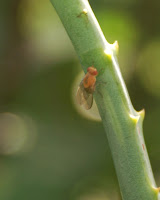
This is Aloe homedepotensis; an unnamed variety picked up long ago on the succulent oddity table at the local warehouse store, before such things were all the rage. Of course, succulents aren't only popular now: They seem to have become necessary to demonstrate a gardener's commitment to conservation and begin green.
Anyway, I have a fair
 number of aloes in the garden and this one is in bloom right now. Nectar drips from the flowers, and a fly (maybe Minettia flaveola? or more likely Photopsis blurrii) perches on the flower stalk below . . . exploiting the drip?
number of aloes in the garden and this one is in bloom right now. Nectar drips from the flowers, and a fly (maybe Minettia flaveola? or more likely Photopsis blurrii) perches on the flower stalk below . . . exploiting the drip?Sure, aloes
 are tough, but in my experience they are appreciative of occasional to regular watering and tolerate of a fair amount of shade in hotter climates. There are a huge number of aloe species, representing a wide range of needs and forms. They come almost exclusively from South Africa; oh, and they are not cacti. Do not use aloes to represent the American southwest! They are lovely in their own right, easy to grow, not native to here.
are tough, but in my experience they are appreciative of occasional to regular watering and tolerate of a fair amount of shade in hotter climates. There are a huge number of aloe species, representing a wide range of needs and forms. They come almost exclusively from South Africa; oh, and they are not cacti. Do not use aloes to represent the American southwest! They are lovely in their own right, easy to grow, not native to here.
No comments:
Post a Comment